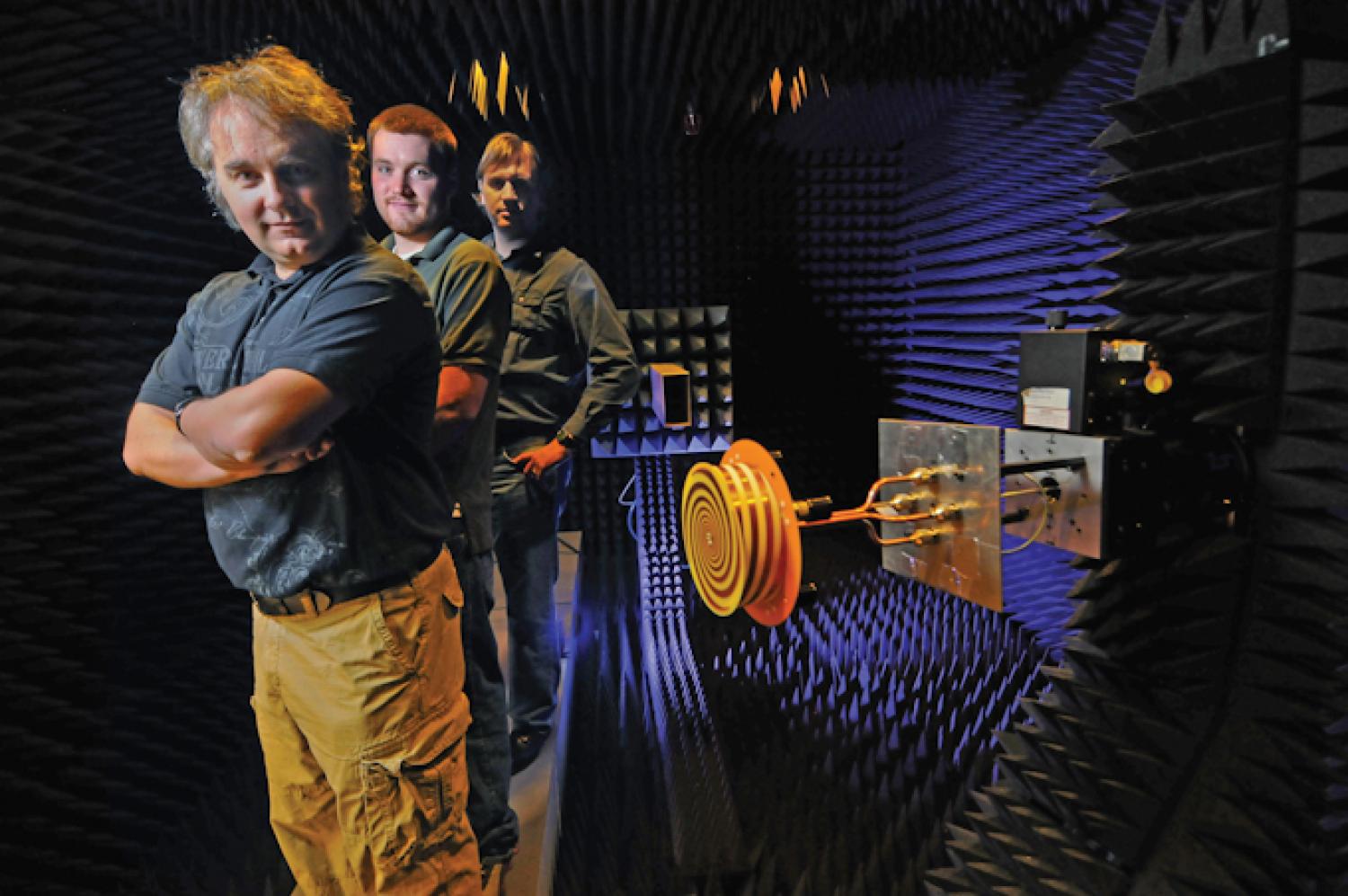Antenna design spirals to new heights

Nearly 20 years ago, as a young engineering student in his native Serbia, Dejan Filipovic won the Nikola Tesla Foundation award for young inventors for his undergraduate thesis on spiral antenna design. The award honors the Serbian-American inventor and engineer, an inspiring figure for Filipovic and many other youngsters from that part of the world.
Like Tesla, Filipovic left his homeland in search of greener pastures. He is now taking the subject of his award-winning thesis to new heights as a CU-Boulder associate professor of electrical, computer, and energy engineering.
Filipovic and his students are developing a new generation of spiral and other frequency independent antennas to achieve previously unattainable performance, including efficiency, power handling, and range, and meet a variety of other specialized needs put forward by the U.S. Department of Defense.
While reducing the size of an antenna typically results in reduced performance, it’s just one of several fundamental challenges in antenna design that Filipovic’s students can—and regularly do—overcome. In one project, they have shown that multi-arm spiral, log-periodic, and sinuous antennas with fully beamformed patterns can be designed and fabricated to operate in excess of 100 GHz, exceeding the range of stateof- the-art devices three to five times. This research can lead to the new wideband, highly sensitive and accurate direction-finding and polarimetric receivers that are so important for future Department of Defense platforms.
Spiral antennas operate over a wide range of frequencies with a consistent impedance and radiation pattern characterized by high-quality circular polarization. They have been traditionally used as RF sensors for electronic support systems including radar warning, direction finding, and spectrum monitoring and surveillance; as well as for wideband terrestrial and satellite communications, ground penetrating radar, and other applications.
The spiral antenna design also may be the answer for another application in which Filipovic has been tasked to design small wideband antennas that can be hidden on military vehicles such as trucks and Humvees so as not to attract attention. While significantly down-scaling the size of the antennas on such vehicles, Filipovic notes that his group must ensure they continue to perform at the same high level, and in a variety of environmental conditions, so that soldiers in the field can communicate back to command, or perform various jamming or diagnostic missions. The research challenge also must take into account the possible health effects of locating higher power electromagnetic devices in close proximity to military personnel as well as coupling with other on-board RF systems.
In addition to improving the performance of the spiral antenna as a receiving device, Filipovic and his students also are researching the ways to make them high-power capable without sacrificing their superior low-power electrical performance.
This decades-long dream of antenna engineers is now close to fruition. Recent experiments have shown that hundreds of watts can be radiated over decade-wide bandwidths with CU-designed frequency independent antennas without any degradation of their physical or electrical features. These findings will pave the way to completely uncharted areas where these antennas can become enabling devices around which new RF systems can be developed.
High-frequency towed-decoy systems, which are the last line of defense for military aircraft, are another area where Filipovic’s research group expertise is being tapped. High-performance transmitting and receiving antennas and microwave components are crucial in seducing an incoming missile and protecting the pilot and aircraft. Wide bandwidth, well controlled impedance, pattern, dispersion, and high power, when coupled with extreme decoy’s deployment conditions, makes this research extremely challenging. Though this three-year grant is in its third quarter, a transmission line designed by Matthew Radway, a post-doctoral fellow in Filipovic’s group, already has been adopted as a baseline medium around which the new decoy will be developed.
Filipovic describes the work as “classical research” that starts with the set of basic equations of the 19th century physicist James Clerk Maxwell, and ends with the enabling concept, device, or subsystem design taken to a new level.
The research is so much in need that he currently has more than $2.5 million in funding, which supports six PhD students along with two undergraduates and three post-doctoral researchers. Four PhD dissertations came out of this research in the past six months, and his students regularly place in the finals, and often win, student competitions.
In part, the research is made possible with a new anechoic chamber, a unique, state-of-the-art facility in the Engineering Center that allows full characterization of antennas, electromagnetic emissions, and RF devices from 1 to 110 GHz. This fully automated and computercontrolled chamber was funded by the Defense University Research Instrumentation Program with the University of Colorado providing necessary space and modification.
Filipovic, who is one of four faculty members in his department born in Serbia, says he enjoys defense-driven work over various commercial applications. First and foremost, it comes down to saving lives rather than saving dollars, he says.
“Growing up in the rural part of (the former) Yugoslavia, being financially rich was never important for my family. Being educated was.”
> Learn more about the Antenna Research Group (ARG)

